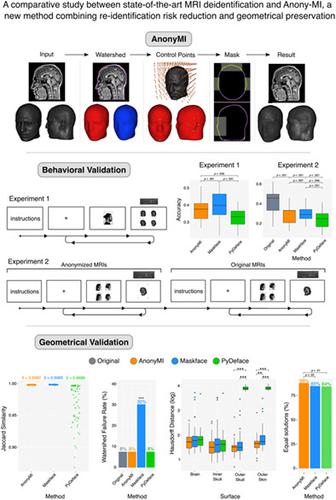当前位置:
X-MOL 学术
›
Hum. Brain Mapp.
›
论文详情
Our official English website, www.x-mol.net, welcomes your
feedback! (Note: you will need to create a separate account there.)
A comparative study between state-of-the-art MRI deidentification and AnonyMI, a new method combining re-identification risk reduction and geometrical preservation
Human Brain Mapping ( IF 3.5 ) Pub Date : 2021-09-14 , DOI: 10.1002/hbm.25639 Ezequiel Mikulan 1 , Simone Russo 1 , Flavia Maria Zauli 1 , Piergiorgio d'Orio 2 , Sara Parmigiani 1 , Jacopo Favaro 3 , William Knight 4 , Silvia Squarza 5 , Pierluigi Perri 6 , Francesco Cardinale 2 , Pietro Avanzini 7 , Andrea Pigorini 1
Human Brain Mapping ( IF 3.5 ) Pub Date : 2021-09-14 , DOI: 10.1002/hbm.25639 Ezequiel Mikulan 1 , Simone Russo 1 , Flavia Maria Zauli 1 , Piergiorgio d'Orio 2 , Sara Parmigiani 1 , Jacopo Favaro 3 , William Knight 4 , Silvia Squarza 5 , Pierluigi Perri 6 , Francesco Cardinale 2 , Pietro Avanzini 7 , Andrea Pigorini 1
Affiliation

|
Deidentifying MRIs constitutes an imperative challenge, as it aims at precluding the possibility of re-identification of a research subject or patient, but at the same time it should preserve as much geometrical information as possible, in order to maximize data reusability and to facilitate interoperability. Although several deidentification methods exist, no comprehensive and comparative evaluation of deidentification performance has been carried out across them. Moreover, the possible ways these methods can compromise subsequent analysis has not been exhaustively tested. To tackle these issues, we developed AnonyMI, a novel MRI deidentification method, implemented as a user-friendly 3D Slicer plugin-in, which aims at providing a balance between identity protection and geometrical preservation. To test these features, we performed two series of analyses on which we compared AnonyMI to other two state-of-the-art methods, to evaluate, at the same time, how efficient they are at deidentifying MRIs and how much they affect subsequent analyses, with particular emphasis on source localization procedures. Our results show that all three methods significantly reduce the re-identification risk but AnonyMI provides the best geometrical conservation. Notably, it also offers several technical advantages such as a user-friendly interface, multiple input–output capabilities, the possibility of being tailored to specific needs, batch processing and efficient visualization for quality assurance.
中文翻译:

最先进的 MRI 去识别与 AnonyMI 的比较研究,一种结合重新识别风险降低和几何保存的新方法
去识别 MRI 是一项紧迫的挑战,因为它旨在排除重新识别研究对象或患者的可能性,但同时它应该保留尽可能多的几何信息,以最大限度地提高数据的可重用性并促进互操作性. 尽管存在多种去识别方法,但尚未对它们的去识别性能进行全面的比较评估。此外,这些方法可能损害后续分析的可能方式尚未经过详尽的测试。为了解决这些问题,我们开发了 AnonyMI,这是一种新颖的 MRI 去识别方法,实现为用户友好的 3D Slicer 插件,旨在提供身份保护和几何保存之间的平衡。为了测试这些功能,我们进行了两组分析,将 AnonyMI 与其他两种最先进的方法进行了比较,以同时评估它们在去识别 MRI 方面的效率以及它们对后续分析的影响程度,特别强调源本地化程序。我们的结果表明,所有三种方法都显着降低了重新识别风险,但 AnonyMI 提供了最佳的几何守恒。值得注意的是,它还提供了一些技术优势,例如用户友好的界面、多种输入输出功能、根据特定需求定制的可能性、批处理和用于质量保证的高效可视化。它们在去识别 MRI 方面的效率如何以及它们对后续分析的影响有多大,特别强调源定位程序。我们的结果表明,所有三种方法都显着降低了重新识别风险,但 AnonyMI 提供了最佳的几何守恒。值得注意的是,它还提供了一些技术优势,例如用户友好的界面、多种输入输出功能、根据特定需求定制的可能性、批处理和用于质量保证的高效可视化。它们在去识别 MRI 方面的效率如何以及它们对后续分析的影响有多大,特别强调源定位程序。我们的结果表明,所有三种方法都显着降低了重新识别风险,但 AnonyMI 提供了最佳的几何守恒。值得注意的是,它还提供了一些技术优势,例如用户友好的界面、多种输入输出功能、根据特定需求定制的可能性、批处理和用于质量保证的高效可视化。
更新日期:2021-11-01
中文翻译:

最先进的 MRI 去识别与 AnonyMI 的比较研究,一种结合重新识别风险降低和几何保存的新方法
去识别 MRI 是一项紧迫的挑战,因为它旨在排除重新识别研究对象或患者的可能性,但同时它应该保留尽可能多的几何信息,以最大限度地提高数据的可重用性并促进互操作性. 尽管存在多种去识别方法,但尚未对它们的去识别性能进行全面的比较评估。此外,这些方法可能损害后续分析的可能方式尚未经过详尽的测试。为了解决这些问题,我们开发了 AnonyMI,这是一种新颖的 MRI 去识别方法,实现为用户友好的 3D Slicer 插件,旨在提供身份保护和几何保存之间的平衡。为了测试这些功能,我们进行了两组分析,将 AnonyMI 与其他两种最先进的方法进行了比较,以同时评估它们在去识别 MRI 方面的效率以及它们对后续分析的影响程度,特别强调源本地化程序。我们的结果表明,所有三种方法都显着降低了重新识别风险,但 AnonyMI 提供了最佳的几何守恒。值得注意的是,它还提供了一些技术优势,例如用户友好的界面、多种输入输出功能、根据特定需求定制的可能性、批处理和用于质量保证的高效可视化。它们在去识别 MRI 方面的效率如何以及它们对后续分析的影响有多大,特别强调源定位程序。我们的结果表明,所有三种方法都显着降低了重新识别风险,但 AnonyMI 提供了最佳的几何守恒。值得注意的是,它还提供了一些技术优势,例如用户友好的界面、多种输入输出功能、根据特定需求定制的可能性、批处理和用于质量保证的高效可视化。它们在去识别 MRI 方面的效率如何以及它们对后续分析的影响有多大,特别强调源定位程序。我们的结果表明,所有三种方法都显着降低了重新识别风险,但 AnonyMI 提供了最佳的几何守恒。值得注意的是,它还提供了一些技术优势,例如用户友好的界面、多种输入输出功能、根据特定需求定制的可能性、批处理和用于质量保证的高效可视化。











































 京公网安备 11010802027423号
京公网安备 11010802027423号